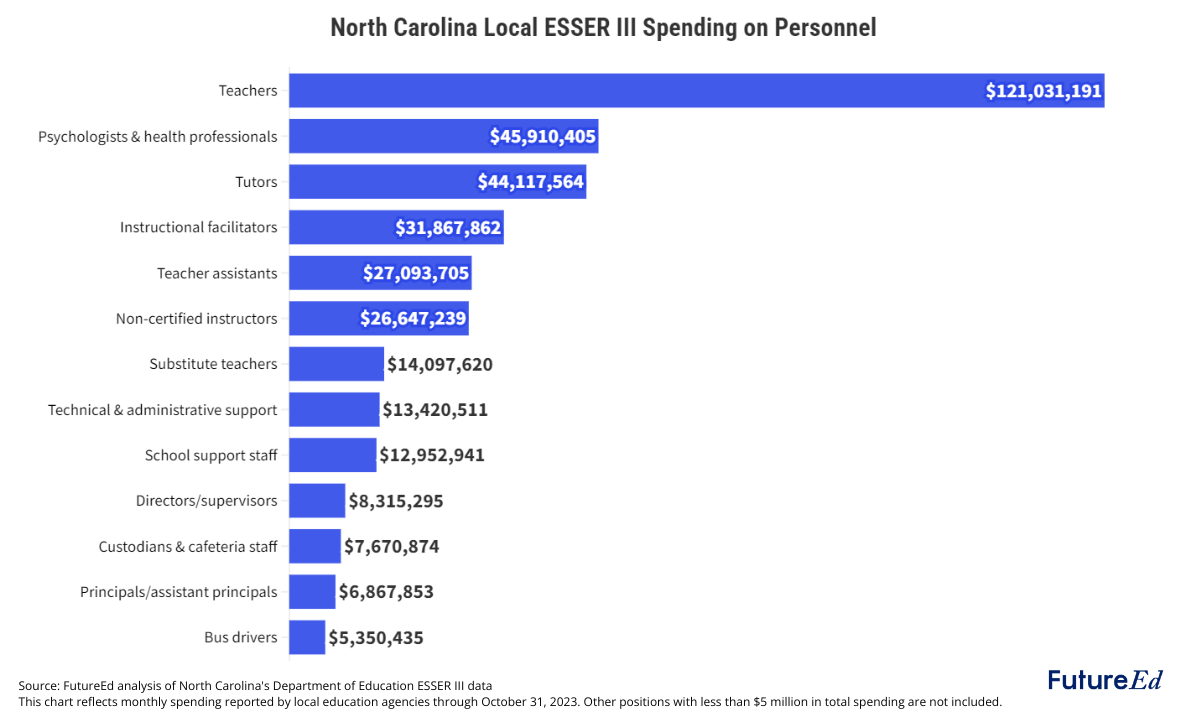North Carolina
How North Carolina spent ESSER funds – EducationNC

 |
This story first appeared at The 74, a nonprofit news site covering education.
Nationally, school districts and charter schools have poured billions of federal pandemic relief dollars into staffing. Most states don’t detail that spending precisely, but North Carolina does. A FutureEd analysis of how North Carolina is spending its last and largest round of federal Elementary and Secondary School Emergency Relief money suggests that localities across the state, especially rural school districts, put larger shares of that money into short-term staffing fixes than into long-term personnel commitments. This decision could potentially ease their fiscal pain when the funds run out.
Of the $3.6 billion the state received in the third and final round of federal relief, about $2.3 billion had been spent or earmarked as of Oct. 31, including $1.2 billion on staffing.
Stressing the short term
Notably, given warnings of looming post-ESSER teacher layoffs, the largest share of North Carolina’s staffing investments — and the single largest last-round expenditure of any sort — went to one-time expenditures.
About 55% of North Carolina’s local education agencies spent some of their third-round ESSER dollars on staff bonuses. That translated to $445 million, or 20% of the final federal installment spent so far. Most of these expenditures occurred in fiscal year 2022, likely reflecting pandemic-related challenges in recruiting and retaining staff.
North Carolina’s state-level data do not show whether bonuses were distributed across the board to thank teachers for their efforts during COVID or targeted to hiring and retention in hard-to-fill areas. But an earlier FutureEd analysis of the nation’s 100 largest school districts’ third-round ESSER plans found that nearly half the districts considering bonuses intended to target them toward specific hard-to-fill positions, hard-to-staff schools or effective teachers. FutureEd’s current analysis of ESSER spending in selected North Carolina school districts revealed that several are using bonuses strategically to hire and keep staff in hard-to-fill jobs. Research has found targeted bonuses to be more effective than across-the-board stipends in attracting and retaining teachers.
Statewide, staff bonuses were most likely in rural areas. “A lot of the more rural districts already face competition (for teachers), especially if they’re bordering a county or a district that is urban and can offer a larger (salary) supplement,” said Rachel Wright-Junio, director of North Carolina’s office of learning recovery and acceleration. “So, I would understand why they would take advantage of awarding bonuses to try to attract and retain teachers.”
Though our analysis suggests that bonuses may have been a wise use of one-time funds, especially when targeted to fill hard-to-staff positions, interviews with North Carolina district leaders suggest that they have also forced some districts to compete for teachers, as some were able to offer higher bonuses than others. Wright-Junio expressed concern that rural districts may see worse teacher and bus driver shortages when the bonus funds run out.
Spending may not equal new hires
North Carolina districts and charter schools have spent nearly $369.3 million of their final round of ESSER funding on staff salaries, with about one-third of the money going to classroom teachers. An additional $50.2 million went for recurring extra payments to attract and retain highly effective educators. These salary supplements are typically set at the local level and paid for with local funds. Though bonuses represent North Carolina’s largest ESSER expenditure, teacher salaries emerged among the top spending priorities in two-thirds of local education agencies.
We found that the number of North Carolina teachers supported by federal funds rose by 23% between 2018-19 and 2022-23 — an increase of 1,300. But the total number of teachers statewide has declined slightly, by 720, from pre-pandemic levels. This suggests that at least some ESSER money has funded existing educators, not new personnel.
While some districts might be paying existing staff with ESSER dollars to free up other funds, our analysis indicates the statewide student-teacher ratio has declined, from 15.1 in 2018-19 to 14.7 in 2022-23. Pandemic funds may have made it possible for school districts to keep teachers they might otherwise have had to let go due to student enrollment declines.
This doesn’t necessarily mean all these positions will automatically disappear when the ESSER money runs out. “You don’t know the counterfactual, which might be that the district would have hired for that new position anyway and used other spending for it,” said Dan Goldhaber, director of the Center for Analysis of Longitudinal Data in Education Research at the American Institutes for Research and a FutureEd research adviser. “I think it probably indicates that some of those teachers are, in fact, going to go when ESSER disappears. But you don’t know that for sure.”
Looking forward
The North Carolina Department of Education has developed several tools to help local education agencies assess which of their investments are most important to sustain. For example, it created a framework for sustainability, called an investment grid, to help districts use performance data to gauge the value of their investments. State education officials are also helping school districts and charters find additional funding for summer learning, tutoring and other priorities. They developed a strategy for districts to align their ESSER investments with existing federal funding programs so they can potentially transition to other federal funding.
Ultimately, North Carolina’s local education agencies are going to face staffing choices as the deadline for spending the state’s remaining $1.2 billion in federal COVID school aid approaches. Their education leaders have spent the largest share of their last round of ESSER monies on bonuses and other short-term investments may make the task a little easier.

North Carolina
Tropical Storm Debby: ‘Historic,’ ‘catastrophic’ flooding possible on South Carolina coast

Tropical Storm Debby closing in on Florida, hurricane warnings issued
Strong winds and rain batter coastal Florida as Tropical Storm Debby intensifies
Tropical Storm Debby, in the Gulf of Mexico Sunday afternoon and headed toward the Big Bend area of Florida, is forecast to impact parts of South Carolina and North Carolina this week. Alerts have been issued for the storm that could bring potentially historic rainfall, rough surf and flooding to these regions.
At 2 p.m. Sunday, the National Hurricane Center issued an advisory for Tropical Storm Debby, noting that it is expected to strengthen into a hurricane before making landfall Monday morning. Debby is expected to move slowly across northern Florida and into southern Georgia before moving into the Atlantic Ocean and up the coast.
The cone that shows the storm’s probable path includes much of S.C. However, many variables remain, including the strength of the still-developing storm and its exact eventual path.
Track Tropical Storm Debby
Track Debby: South Carolina Storm Tracker and Model Mixer
What can we expect in South Carolina?
The Hurricane Center’s forecast shows the center of the storm reaching South Carolina by about 8 p.m. Tuesday. But effects like heavy rain could start as early as Monday night.
Rainfall along the coast is expected to be the main concern. The S.C. coast from the southern part of the state past the Charleston area could see 16-20 inches of rain, with local amounts of up to 30 inches. That will likely result in “considerable” flash and urban flooding, and some river flooding is possible, the Hurricane Center said.
“Heavy rainfall will likely result in considerable flooding impacts from the Florida Big Bend region through southeast Georgia and the Coastal Plain of the Carolinas through Friday,” the Hurricane Center said. “Potentially historic heavy rainfall across southeast Georgia and South Carolina through Friday morning may result in areas of catastrophic flooding. Significant river flooding is also expected.”
The likelihood of storm surges creates a life-threatening situation, the Hurricane Center said. Persons located within these areas should take all necessary actions to protect life and property from rising water and the potential for other dangerous conditions. Promptly follow evacuation and other instructions from local officials.
Rain of about 1-4 inches is forecast for parts of the Upstate.
What watches and warnings are in effect in South Carolina?
A flood watch is in effect from 2 a.m. Monday through Friday morning for southeast South Carolina, including Allendale, Beaufort, Charleston, Coastal Colleton, Coastal Jasper, Dorchester, Hampton, Inland Berkeley, Inland Colleton, Inland Jasper and Tidal Berkeley.
A tropical storm watch is in effect for Charleston, McClellanville and Edisto Island. The forecast calls for winds of 20-30 mph with gusts to 40 mph.
A storm surge watch is in effect beginning Monday afternoon for Charleston, McClellanville and Edisto Island, with a potential of 2-4 feet above ground.
What other watches and warnings are in effect?
As of Sunday afternoon the depression was about 125 miles west-southwest of Tampa, Florida.
- A hurricane warning is in effect for Florida coast from the Suwannee River to the Ochlockonee River.
- A hurricane watch is in effect for the Florida coast west of the Ochlockonee River to Indian Pass * Florida coast south of the Suwannee River to Yankeetown.
- A tropical storm warning is in effect for the Dry Tortugas, the Florida coast south of the Suwannee River to East Cape Sable and the Florida coast west of the Ochlockonee River to Indian Pass.
- A tropical storm watch is in effect for the Florida coast west of Indian Pass to Mexico Beach, and the Georgia and South Carolina coast from the Mouth of the St. Mary’s River to South Santee River South Carolina.
- A storm surge warning is in effect for the Florida coast from the middle of Longboat Key northward to Indian Pass including Tampa Bay.
- A storm surge watch is in effect for the Florida coast from Bonita Beach northward to the middle of Longboat Key, including Charlotte Harbor, and thr Georgia and South Carolina coast from the Mouth of the St. Mary’s River to South Santee River South Carolina.
More: When is first day of fall? SC’s weather forecast by Old Farmer’s Almanac; is it accurate?
More: Heat wave continues, cooling stations open in Spartanburg County. What about Greenville?
Where is Tropical Storm Debby?
Track it: South Carolina Storm Tracker and Model Mixer
Conditions at 2 p.m. Aug. 4:
- Location: 125 miles west-southwest of Tampa, Florida.
- Maximum sustained winds: 65 mph.
- Movement: North-northwest at 13 mph.
More: Heat advisory in effect for Greenville, Spartanburg and Anderson, precautions to stay cool
Are you prepared for a hurricane?
Hurricane season runs from June 1 to Nov. 30. Even if this system won’t pose a threat to the Upstate, it’s never too early to be prepared.
Iris Seaton, Carolinas Connect, and Cheryl McCloud, USA TODAY NETWORK – Florida, contributed.
Todd Runkle is the Carolinas Connect editor and also a content coach for the Asheville Citizen Times, part of the USA TODAY Network. Reach him at trunkle@gannett.com.
North Carolina
North Carolina Zoo celebrates its 50 anniversary

ASHEBORO, N.C. (WTVD) — The North Carolina Zoo is celebrating 50 years.
Located in Asheboro, the zoo houses about 1,700 animals and over 250 species primarily from Africa and North America.
On social media, NC Zoo wrote Friday:
“Throughout our history, we’ve been home to a diverse array of remarkable animals, dedicated keepers, and passionate employees who work tirelessly behind the scenes. Join us in honoring this milestone by visiting the Zoo in 2024!”
The Zoo also mentioned the Zoo’s first animals, which were two Galapagos tortoises named Tort and Retort.
The post said in part: “These two tortoises symbolize the early days of the North Carolina Zoo and are cherished deeply in our hearts.”
The North Carolina Zoo is one of two state-supported zoos in the country. The other is the Minnesota Zoo.
Copyright © 2024 WTVD-TV. All Rights Reserved.
North Carolina
NC has some of the most dangerous roads in the US: See how Wilmington-area counties rank
With a recent study revealing North Carolina as one of the states with the riskiest roads to travel, some may wonder how safe the roads are here in the Cape Fear region.
MarketWatch Guides, a site that provides “reviews of consumer products and services to help readers make educated purchasing decisions,” focuses in part on car insurance comparisons, vehicle safety and more.
A recent study by the site analyzed factors including annual miles driven per 100,000 system miles, percentage of rough roads and fatal injuries per 100,000 licensed drivers. States were given a rating out of 10 points, with 10 being the most dangerous.
More: Distracted driving in Wilmington: How big of a problem is it?
North Carolina’s ranking among the most dangerous
According to the study, the states with the most dangerous drivers based on the factors studied are:
- Louisiana – 7.55/10
- California – 7.21/10
- New Mexico – 6.74/10
- Hawaii – 6.73/10
- Delaware – 6.67/10
- New Jersey – 6.53/10
- Mississippi – 6.47/10
- North Carolina – 6.39/10
- Massachusetts – 6.33/10
- Maryland and Texas – 6.26/10
According to the study, North Carolina had 32.5 fatal injuries per 100,000 licensed drivers, but only 2.1% of rough roads, which was the lowest percentage out of the other ranked states.
For a more localized perspective, the North Carolina Department of Transportation releases annual traffic crash facts data. The most recent 2022 report includes a ranking of counties based on several factors, including reported crashes, crash severity, crash rates based on population, registered vehicles and estimated vehicle miles traveled.
The most dangerous county for drivers, ranked at No. 1 for the past five years, was Robeson County. The county had 60 fatal crashes in 2022 with 1,136 non-fatal injury crashes. The rest of the total 4,056 crashes were property-damage-only. The county with the best ranking was Hyde County, coming in at No. 100. The county had one fatal crash in 2022 and 10 non-fatal injury crashes. The county had a total of 45 crashes, the rest of which were property damage only.
More: MyReporter: Which intersections see the most red-light camera violations in Wilmington?
Here’s where the Cape Fear region counties ranked.
Brunswick County
Ranked No. 76 in 2022, Brunswick County had 25 fatal crashes and 715 non-fatal injury crashes. The total crashes for that year were 3,146. The remainder of the crashes were property damage only.
New Hanover County
Ranked No. 58, New Hanover had 19 fatal crashes and 1,313 non-fatal injury crashes, both of which went down from 2021. The total crashes in New Hanover were 5,617. The remainder of the crashes were property damage only.
Pender County
Ranked No. 47, Pender County had the worst ranking despite having the lowest number of crashes. The county had 12 fatal crashes and 374 non-fatal injury crashes, and a total of 1,156 crashes. The rest of the crashes were property damage only.
Iris Seaton, USA Today Network, contributed to this report.
-

 Mississippi5 days ago
Mississippi5 days agoMSU, Mississippi Academy of Sciences host summer symposium, USDA’s Tucker honored with Presidential Award
-

 Politics1 week ago
Politics1 week agoRepublicans say Schumer must act on voter proof of citizenship bill if Democrat 'really cares about democracy'
-

 Politics1 week ago
Politics1 week agoTrump announces to crowd he 'just took off the last bandage' at faith event after assassination attempt
-
World7 days ago
More right wing with fewer women – a new Parliament compendium
-

 World1 week ago
World1 week agoIsrael says Hezbollah crossed ‘red line’, strikes deep inside Lebanon
-

 Politics1 week ago
Politics1 week agoHarris failed to combat ‘root causes’ of illegal immigration, former Border Patrol union chief says
-

 News1 week ago
News1 week agoVideo: Kamala Harris May Bring Out Trump’s Harshest Instincts
-

 World1 week ago
World1 week agoItaly's Via Appia enters the Unesco World Heritage List
















